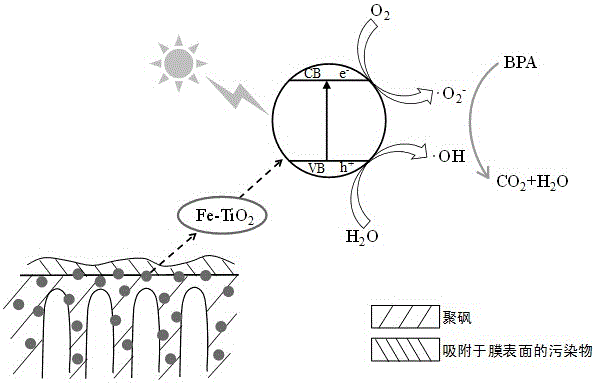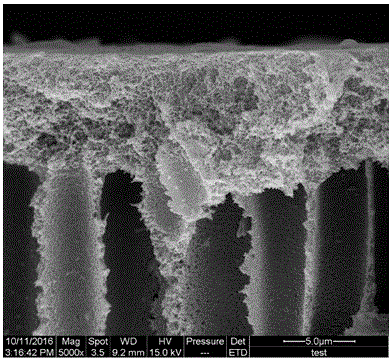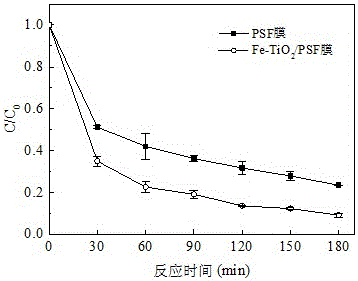Preparation method of visible light catalytic composite ultrafiltration membrane
A visible light and ultrafiltration membrane technology, applied in the field of photocatalysis, can solve the problems of easy loss and difficult recovery of powdered catalysts, and achieve the effects of improved physical and chemical properties, reasonable structure, and small powder particle size
- Summary
- Abstract
- Description
- Claims
- Application Information
AI Technical Summary
Problems solved by technology
Method used
Image
Examples
specific Embodiment approach 1
[0020] Specific embodiment one: the preparation method of the visible light catalytic composite ultrafiltration membrane in this embodiment is realized according to the following steps:
[0021] 1. Weigh the transition metal nitrate and titanium dioxide powder with a molar ratio of 1:50~1:500, add them to 60 mL of deionized water, mix them evenly, pour them into a polytetrafluoroethylene reactor, and put them under the condition of 120~220 ℃ After reacting for 6-24 hours, cooling to room temperature, centrifuging and washing several times, vacuum drying at 70 °C, grinding and sieving through a 300-mesh sieve to obtain a metal-doped titanium dioxide visible light catalyst;
[0022] 2. Blend the photocatalyst obtained in step 1 with the polysulfone membrane material at a mass ratio of 0.05 to 0.3, and vigorously mechanically stir it in a water bath at 30°C for 24 hours to obtain a uniformly mixed casting solution. Degassing to obtain a uniform and bubble-free casting solution; ...
specific Embodiment approach 2
[0024] Embodiment 2: The difference between this embodiment and Embodiment 1 is that the transition metal nitrate in step 1 is copper nitrate, iron nitrate, zinc nitrate or nickel nitrate. Other steps and parameters are the same as those in Embodiment 1.
specific Embodiment approach 3
[0025] Embodiment 3: This embodiment is different from Embodiment 2 in that: in step 1, the transition metal nitrate is ferric nitrate. Other steps and parameters are the same as in the second embodiment.
PUM
| Property | Measurement | Unit |
|---|---|---|
| Pure water flux | aaaaa | aaaaa |
Abstract
Description
Claims
Application Information
 Login to View More
Login to View More - R&D
- Intellectual Property
- Life Sciences
- Materials
- Tech Scout
- Unparalleled Data Quality
- Higher Quality Content
- 60% Fewer Hallucinations
Browse by: Latest US Patents, China's latest patents, Technical Efficacy Thesaurus, Application Domain, Technology Topic, Popular Technical Reports.
© 2025 PatSnap. All rights reserved.Legal|Privacy policy|Modern Slavery Act Transparency Statement|Sitemap|About US| Contact US: help@patsnap.com



